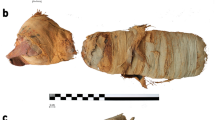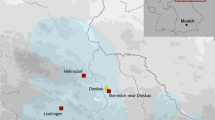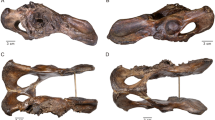Abstract
The Archaeoraptor fossil was announced as a 'missing link' and purported to be possibly the best evidence since Archaeopteryx that birds did, in fact, evolve from certain types of carnivorous dinosaur1. It reportedly came from Early Cretaceous beds of China that have produced other spectacular fossils transitional between birds and extinct non-avian dinosaurs2,3. But Archaeoraptor was revealed to be a forgery in which bones of a primitive bird and a non-flying dromaeosaurid dinosaur had been combined4,5,6. Here we use high-resolution X-ray computed tomography (CT)7 to determine the nature and extent of the forgery, as well as how it was built, by imaging the fracture pattern and distribution of materials through the entire specimen.
This is a preview of subscription content, access via your institution
Access options
Subscribe to this journal
Receive 51 print issues and online access
$199.00 per year
only $3.90 per issue
Buy this article
- Purchase on Springer Link
- Instant access to full article PDF
Prices may be subject to local taxes which are calculated during checkout

Similar content being viewed by others
References
Sloan, C. P. Natl Geogr. Mag. 196(5), 98–107 (1999).
Qiang, J., Currie, P. J., Norell, M. A. & Shu-An, J. Nature 393, 753–761 (1998).
Xu, X., Wang, X.-L., Zhang, F.-C. & Wu, X.-C. Nature 401, 262–265 (1999).
Dalton, R. Nature 403, 689–690 (2000).
Dalton, R. Nature 404, 696 (2000).
Holden, C. Science 288, 238–239 (2000).
Rowe, T., Kappelman, J., Carlson, W. D., Ketcham, R. A. & Denison, C. Geotimes 42, 23–27 (1997).
Dingus, L. & Rowe, T. The Mistaken Extinction — Dinosaur Evolution and the Origin of Birds (Freeman, New York, 1997).
Xu, X., Zhou, Z. & Wang, X. Nature 408, 705–708 (2000).
Weiner, J. S. The Piltdown Forgery (Oxford University Press, London, 1955).
Jahn, M. E. & Woolf, D. J. The Lying Stones of Dr. Johann Bartholomew Adam Berringe (University of California Press, Berkeley, 1963).
Author information
Authors and Affiliations
Corresponding author
Supplementary information
Supplementary information
High resolution CT analysis of the Archaeoraptor forgery, including 4 figures and legends.
Animation 1
Quicktime movie of consecutive high-resolution X-ray CT slices of the Archaeoraptor slab, as it was present for scanning on July 29, 1999. This is the original CT slice plane. The imagery is depicted in shades of gray, to resemble conventional X-radiograms. The densest materials in the slab, which are bone and metallic inclusions in the grout, are depicted in white pixels; air is depicted in black. An approximately linear scale links pixel value with relative density.
Animation 2
Quicktime movie of Archaeoraptor slab, sliced in planes parallel to the slab surface. For this animation, a digital volumetric model of the entire slab was made from the original slice data (animation 1), and then re-sliced at an orthogonal axis. The last frames of the backing slab were deleted to facilitate Web delivery.
Rights and permissions
About this article
Cite this article
Rowe, T., Ketcham, R., Denison, C. et al. The Archaeoraptor forgery. Nature 410, 539–540 (2001). https://doi.org/10.1038/35069145
Issue Date:
DOI: https://doi.org/10.1038/35069145
This article is cited by
-
An extraordinary fossil captures the struggle for existence during the Mesozoic
Scientific Reports (2023)
-
Experimental Investigation of the Influence of Bedding Planes and Differential Stress on Microcrack Propagation in Shale Using X-Ray CT Scan
Geotechnical and Geological Engineering (2021)
-
X-ray computed tomography (XCT) and chemical analysis (EDX and XRF) used in conjunction for cultural conservation: the case of the earliest scientifically described dinosaur Megalosaurus bucklandii
Heritage Science (2018)
-
X-ray computed tomography datasets for forensic analysis of vertebrate fossils
Scientific Data (2016)
-
Fractal Dimension and Maximum Roughness Applied as Sculpture Descriptor for Tektites
Mathematical Geosciences (2012)
Comments
By submitting a comment you agree to abide by our Terms and Community Guidelines. If you find something abusive or that does not comply with our terms or guidelines please flag it as inappropriate.



